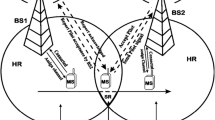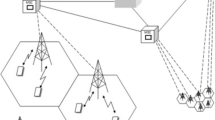Abstract
Call admission control is one of the key elements to guarantee the handoff call dropping probability in cellular networks. Among numerous proposals in the literature, the distributed call admission control policy (DCAC) seems to be promising, due to its simplicity and adaptability to changing traffic. However, one crucial assumption used in DCAC is that the actually admitted new calls has to obey a Poisson process to enter the network after the call admission control. Given the dynamic and distributed nature of the control process, this can neither be validated nor be easily implemented. In this paper, we will first discuss a generalized DCAC which eliminates the above assumption and can be used in general environments. Then, a mobility-aware DCAC is introduced, which considers the difference of handoff support between low and high mobility calls in making the CAC decision in order to improve channel utilization. The performance of the modified DCAC scheme is investigated through simulation studies.
Similar content being viewed by others
References
R. Guerin, Queueing-blocking system with two arrival streams and guard channels, IEEE Transaction on Communications 36(2) (February 1988) 153–163.
D. Hong and S.S. Rappaport, Traffic model and performance analysis for cellular mobile radio telephone systems with prioritized and nonpriorotized handoff procedures, IEEE Transactions on Vehicular Technology 35(3) (1986) 77–92.
D. Hong and S.S. Rappaport, Priority oriented channel access for cellular systems serving vehicular and portable radio telephones, IEE Proceedings 136(5) (October 1989) 339–346.
S.M. Jiang, Danny H.K. Tsang and B. Li, Subscriber-assisted handoff support in multimedia PCS, ACM Mobile Computing and Communication Review 1(3) (September 1997) 29–36.
D.A. Levine et al., A resource estimation and call admission algorithm for wireless multimedia networks using the shadow cluster concept, IEEE/ACM Transactions on Networking 5(1) (February 1997) 1–12.
V.O.K. Li and X.M. Qiu, Personal communication systems (PCS), Proceedings of the IEEE 83(9) (September 1995) 1210–1243.
Y.B. Lin, A. Noerpel and D. Harasty, The sub-rating channel assignment strategy for PCS hand-offs, IEEE Transactions on Vehicular Technology 45(1) (1996) 122–130.
X.Y. Luo, I. Thng and W. Zhuang, A dynamic channel pre-reservation scheme for handoffs with QoS guarantee in mobile networks, in: IEEE ISCC'99.
MIL 3 Inc., OPNET Modeler, 4.0.A.
M. Nagshineh and M. Schwartz, Distributed call admission control in mobile/wireless networks, IEEE Journal on Selected Areas in Communications 14(4) (May 1996) 711–716.
E.C. Posner and R. Guerin, Traffic policies in cellular radio that minimize blocking of handoff calls, in: ITC-11, Kyoto (1985).
R. Ramjee, R. Nagarajan and D. Towsley, On optimal call admission control in cellular networks, in: INFOCOM'96 (1996) 43–50.
S.S. Rappaport, Blocking, hand-off and traffic performance for cellular communication systems with mixed platforms, IEE Proceedings, 140(5) (October 1993) 389–401.
Author information
Authors and Affiliations
Rights and permissions
About this article
Cite this article
Jiang, S., Li, B., Luo, X. et al. A Modified Distributed Call Admission Control Scheme and Its Performance. Wireless Networks 7, 127–138 (2001). https://doi.org/10.1023/A:1016681405149
Issue Date:
DOI: https://doi.org/10.1023/A:1016681405149




